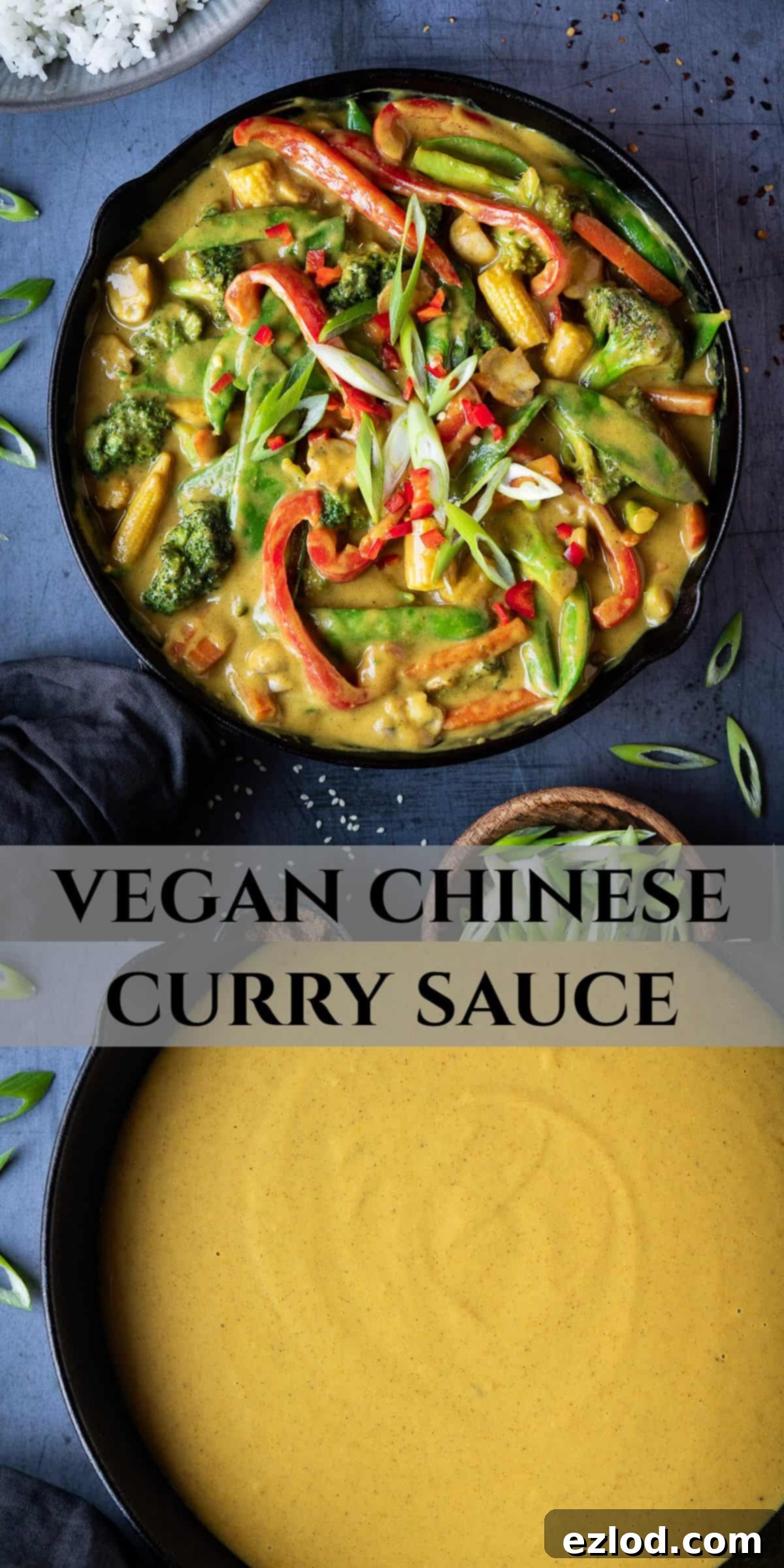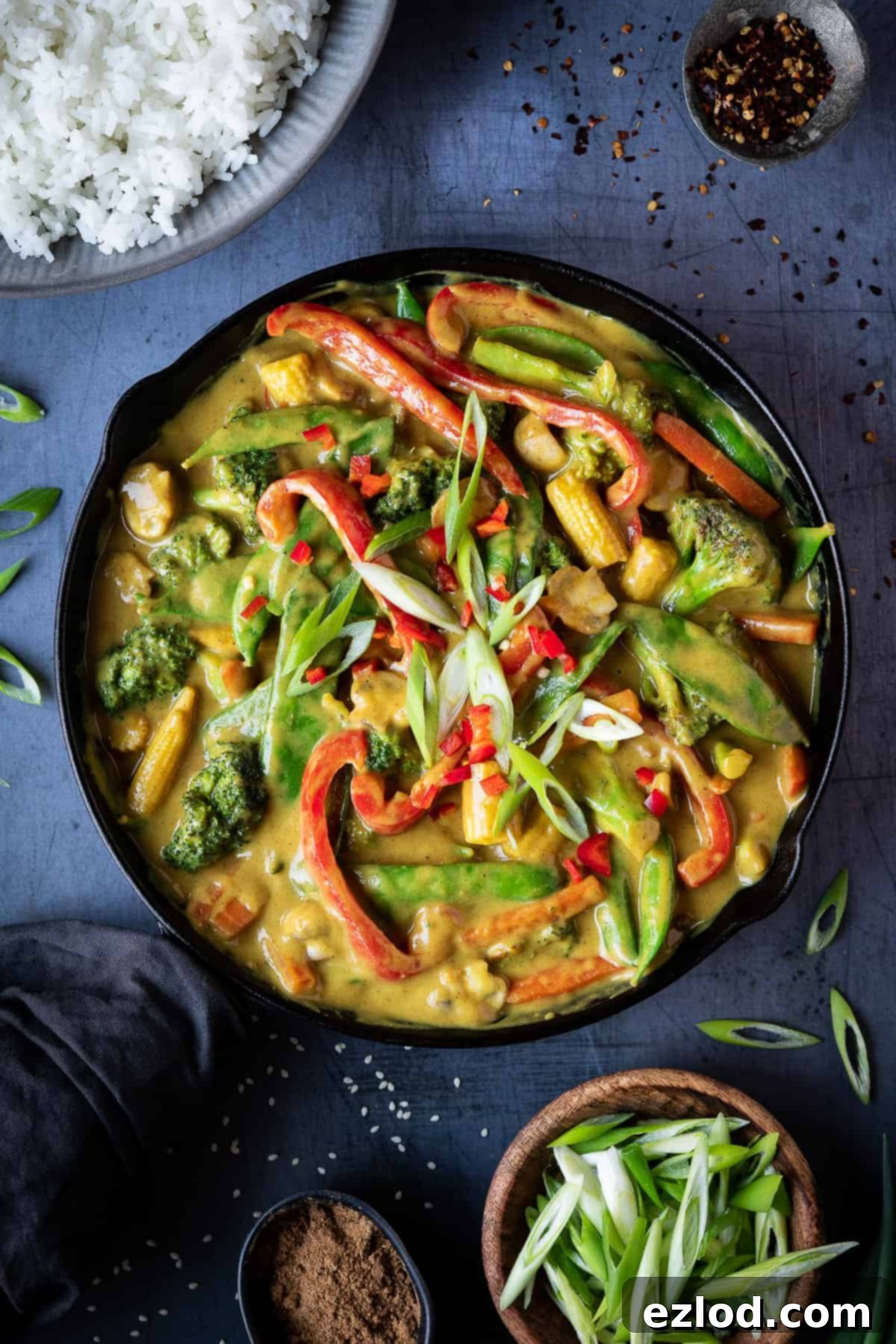The Ultimate Vegan Chinese Curry Sauce: Recreate Authentic Takeaway Flavor at Home
Craving that classic British Chinese takeaway curry? Look no further! This homemade vegan Chinese curry sauce is incredibly easy to make and captures the nostalgic, rich, and slightly sweet flavor you love, but even better. Perfect with vegan chicken, crispy baked tofu, or a medley of stir-fried vegetables.
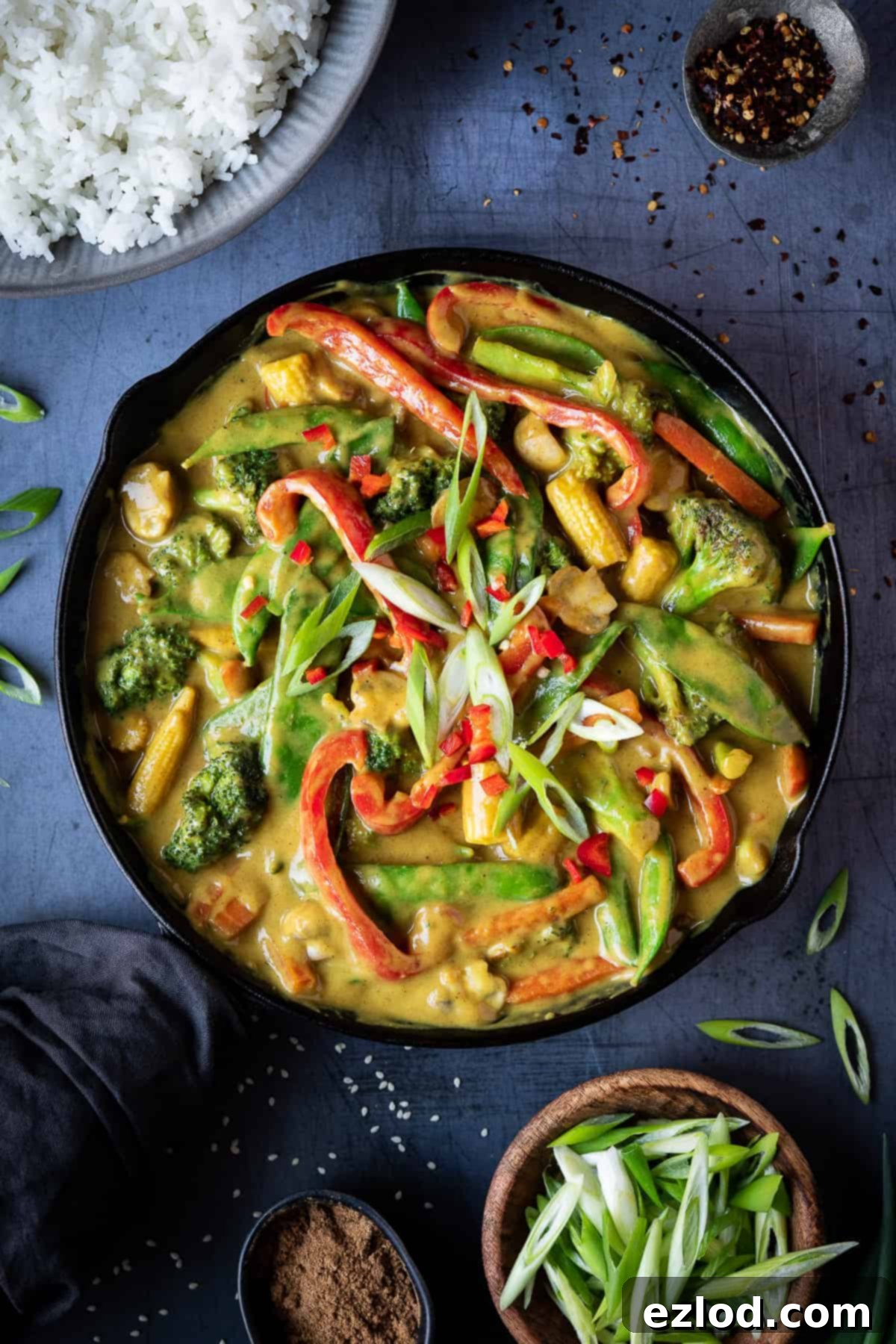
The allure of a Chinese takeaway curry is undeniable, especially in Britain where it holds a special place in the culinary landscape. This vegan Chinese curry recipe offers an authentic homemade rendition of that beloved, comforting sauce – the kind you’d typically find gracing menus at your local chip shop or Chinese restaurant. While its exact origins might be a fascinating blend of culinary traditions, this particular style of Chinese curry is a British institution, a true testament to the beauty of fusion food. It’s a milder, subtly sweet, and wonderfully thick curry sauce, often characterized by its distinctive yellow hue and the aromatic punch of Chinese five-spice powder. This unique blend of spices is the secret ingredient, distinguishing it from other curry varieties and giving it that unmistakable ‘Chinese’ identity.
Traditionally, this curry sauce is a versatile companion, served generously over succulent chicken pieces, mixed with fresh vegetables, or famously, as a delightful dip for golden, crispy chips. Indeed, for many, ‘chips and curry sauce’ is the quintessential post-night-out comfort food, a warm and satisfying embrace after a long evening. Our vegan version ensures that everyone can enjoy this classic, without compromising on taste or texture. It’s incredibly adaptable, allowing you to pair it with your favourite plant-based proteins and a rainbow of fresh vegetables, creating a meal that’s both nourishing and deeply satisfying.
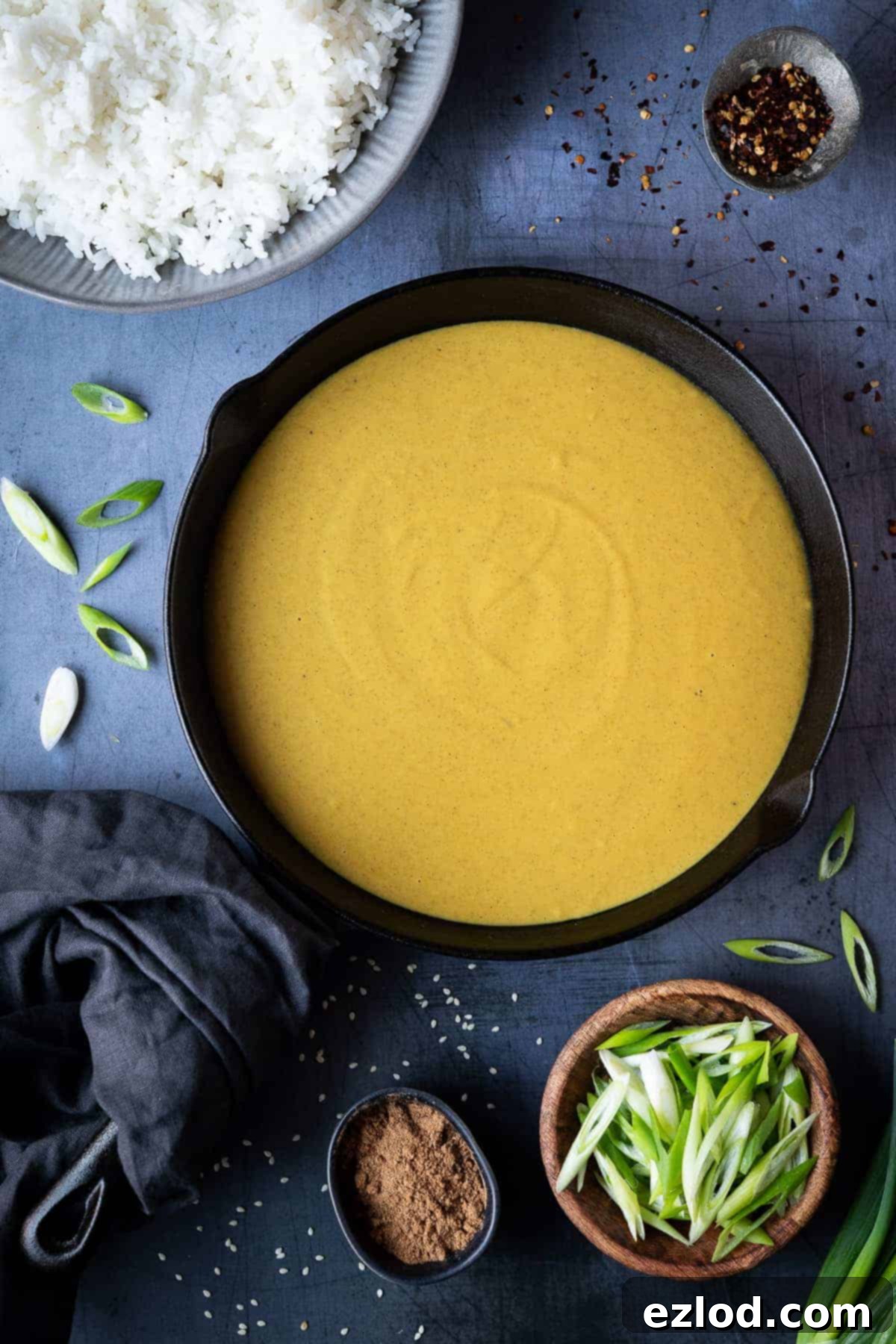
Essential Ingredients for Your Vegan Chinese Curry Sauce:
Crafting this takeaway-style curry sauce from scratch requires a few key components, each playing a vital role in building its signature flavor profile. Here’s what you’ll need and why:
- Chinese Five Spice: This is arguably the most critical ingredient. A cornerstone of Chinese cooking, this blend typically includes star anise, cloves, Chinese cinnamon, Szechuan peppercorns, and fennel seeds. It imparts that distinctive, warm, sweet, and slightly savory aroma that instantly signals ‘Chinese curry’. Do not skip this; it’s what makes the sauce truly authentic to the takeaway experience.
- Curry Powder: For this particular style of Chinese curry, a mild curry powder is recommended. This isn’t meant to be an intensely spicy dish, but rather a flavorful, aromatic one. A standard supermarket mild curry powder works perfectly. Feel free to adjust the heat level by choosing a medium or hot curry powder if you prefer a bit more kick.
- Turmeric: Beyond its subtle earthy notes, turmeric is primarily included here for its vibrant color. It gives the sauce that characteristic golden-yellow hue that is synonymous with British Chinese curry. It also boasts impressive health benefits, making it a welcome addition.
- Coconut Milk: While not universally found in every Chinese curry sauce recipe, I firmly believe that coconut milk elevates this dish significantly. It contributes a luxurious creaminess and a subtle sweetness that beautifully balances the spices, resulting in a much richer and more indulgent sauce. Both full-fat and light coconut milk will work, though full-fat will yield a thicker, more decadent sauce.
- Cornflour (Cornstarch): A staple in Chinese cuisine for thickening sauces, cornflour provides that desired silky, smooth consistency. It’s crucial to create a ‘slurry’ by mixing it with cold water before adding it to the hot sauce to prevent lumps. A vital tip: add the cornflour slurry *after* you have blended the sauce. If you blend the sauce once it’s thickened with cornflour, it tends to become runny again due to the shearing action breaking down the starch molecules. Arrowroot powder can be used as an alternative thickener.
- Onion, Garlic, and Ginger: These aromatic powerhouses form the foundational flavor base of almost any good curry. Gently frying the onion until soft unlocks its sweetness, while fresh ginger and garlic provide pungent, warming notes that are essential for depth and complexity.
- Soy Sauce and Vegetable Stock: These two ingredients are fundamental for building a savory, umami-rich flavor profile. Soy sauce adds salinity and a deep, complex savoriness, while vegetable stock forms the liquid base, infusing the sauce with hearty vegetable goodness. Opt for a low-sodium soy sauce if you are mindful of salt intake.
- Sugar: Just a touch of sugar is added to achieve that slightly sweet, ‘chip shop’ authentic taste. It balances the savory and spicy elements, rounding out the flavor profile beautifully. You can adjust this to your personal preference.
- Vegan Butter: While olive oil can certainly be used, frying the initial aromatics and spices in vegan butter adds an extra layer of richness and depth of flavor. It contributes a lovely mouthfeel and a subtly creamy undertone that enhances the overall experience.
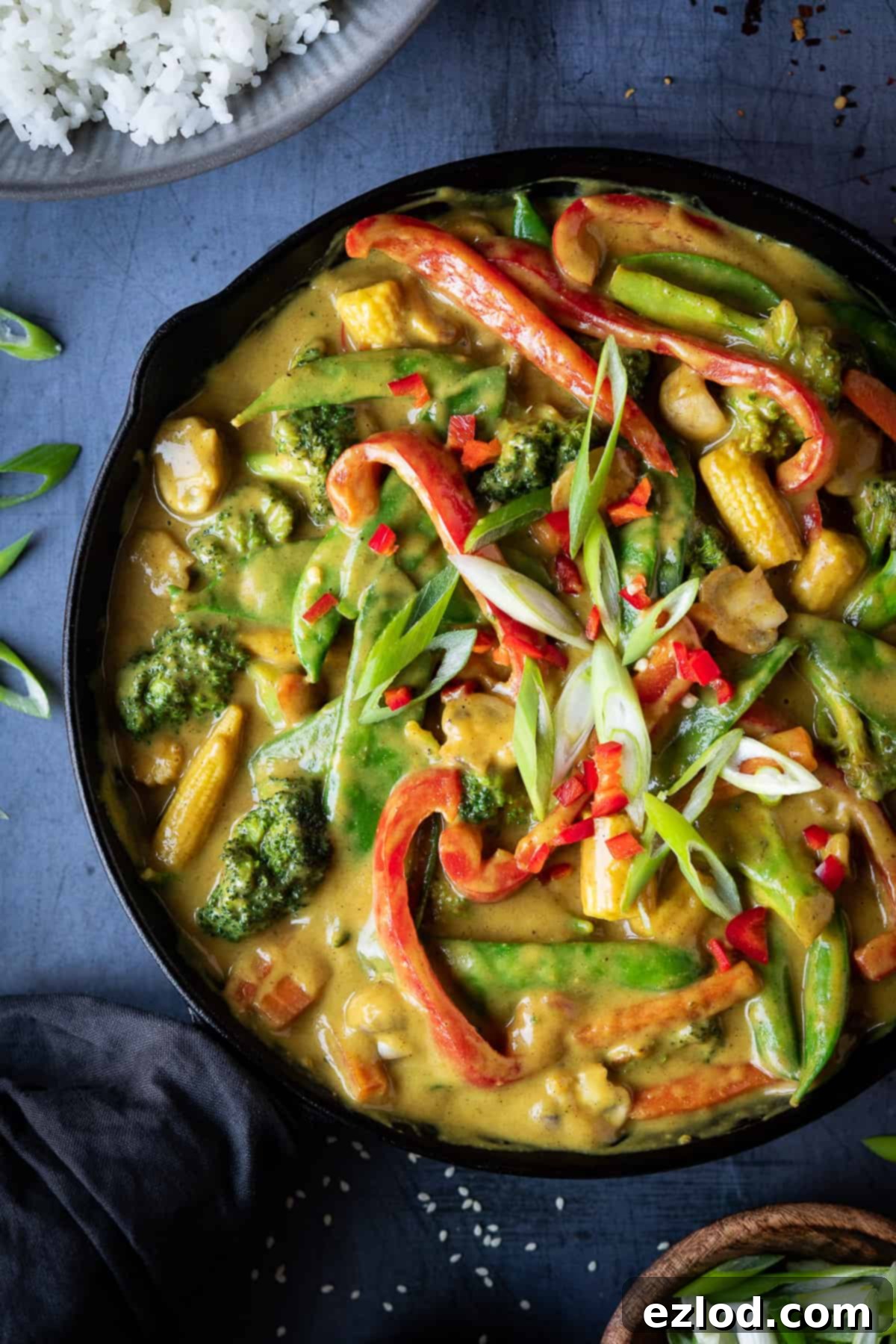
Crafting Your Vegan Chinese Curry Sauce: Step-by-Step Guide
(For a detailed ingredient list and precise instructions, please refer to the recipe card below.)
The process of making this luscious vegan Chinese curry sauce at home is surprisingly straightforward, allowing you to achieve authentic takeaway flavors with minimal effort. Here’s how to do it:
- Sauté the Aromatics: Begin by melting your vegan butter (or heating olive oil) in a large saucepan or pot over a low to medium heat. Add your finely chopped brown onion and cook it gently for about 8-10 minutes. The key here is to soften the onion until it’s translucent and sweet, not browned or caramelized. This gentle cooking releases its natural sugars, which contribute to the sauce’s depth.
- Bloom the Spices: Once the onion is perfectly soft, stir in the grated ginger, crushed garlic, mild curry powder, Chinese five-spice, and turmeric. Continue to cook for another two to three minutes, stirring frequently. This crucial step, known as “blooming” the spices, gently toasts them in the fat, intensifying their aromas and flavors before any liquid is added. You’ll notice a wonderful fragrant aroma filling your kitchen.
- Simmer for Flavor: Pour in the tin of coconut milk, followed by the vegetable stock, dark soy sauce, and the specified amount of sugar. Crumble in a vegetable stock cube for an extra boost of savory flavor. Bring the mixture to a gentle simmer and let it cook for at least ten minutes. This simmering period allows all the incredible flavors to meld and deepen, creating a harmonious base for your curry.
- Achieve Silkiness through Blending: Carefully transfer the hot sauce mixture to a blender. Blitz it until it reaches a perfectly smooth and creamy consistency. This step is essential for achieving that characteristic silky texture of a takeaway curry sauce. Once smooth, pour the sauce back into the clean saucepan.
- Thicken to Perfection: In a small bowl, combine the cornflour (cornstarch) with two tablespoons of cold water, stirring vigorously to create a smooth, lump-free slurry. Stir this cornflour slurry gradually into the sauce in the pan. Bring the sauce back up to a gentle simmer, cooking for another couple of minutes while stirring constantly. As the sauce heats, the cornflour will activate and thicken the curry to its desired consistency. Constant stirring prevents any lumps from forming.
- Season and Serve: Taste the sauce and adjust the seasoning as needed with salt and pepper. At this point, you can also add a little more curry powder or five-spice if you desire a stronger flavor, or a dash of your favorite chili sauce (like Sriracha or sweet chili sauce) if you prefer a spicier kick. Remember to adjust salt and pepper at the end. Your homemade vegan Chinese curry sauce is now ready to be enjoyed with your choice of accompaniments!
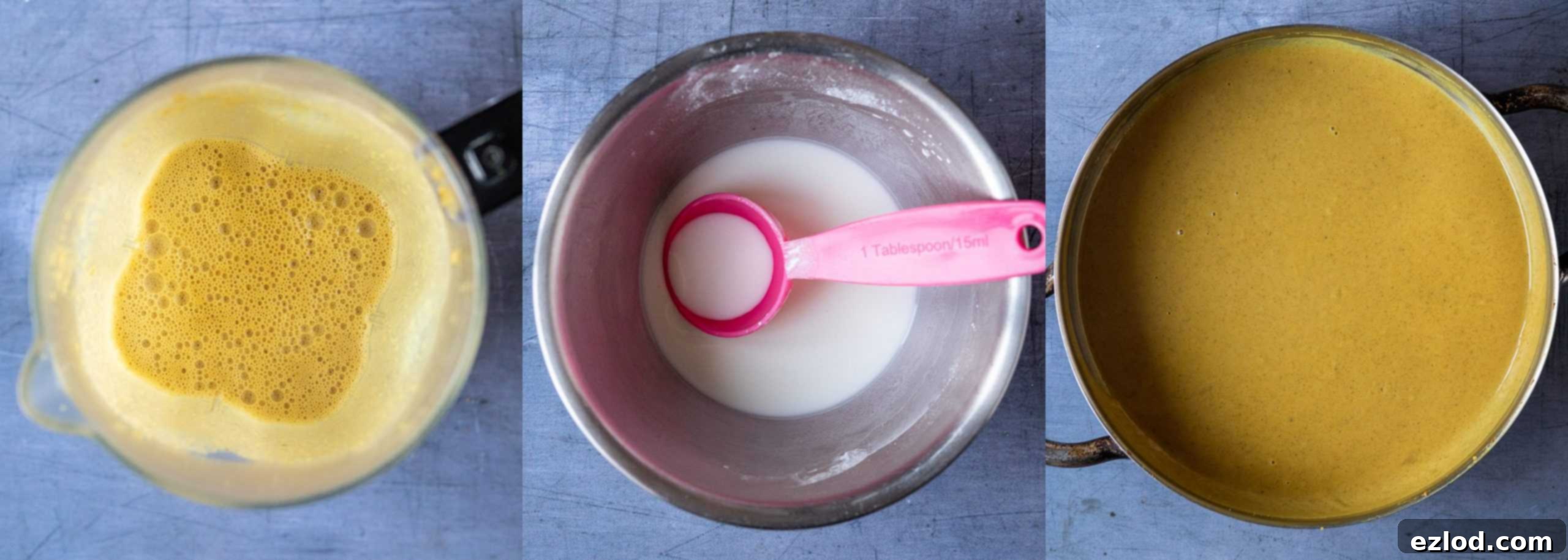
Perfect Pairings: What to Serve with Your Vegan Chinese Curry Sauce
One of the joys of this vegan Chinese curry sauce is its incredible versatility. It truly shines when paired with a variety of proteins, vegetables, and carbohydrates, allowing you to customize your meal to your exact preferences. I’ve intentionally kept the serving suggestions broad to encourage creativity in your kitchen:
- Vegan Protein Powerhouses:
- Vegan Chicken Pieces: Since traditional Chinese curry often features chicken, vegan chicken-style pieces are an excellent, familiar choice. Simply cook them according to package instructions (pan-fry, bake, or air-fry) until golden and tender, then stir them directly into the hot sauce just before serving.
- Baked Tofu: Firm or extra-firm tofu, pressed and baked until golden and slightly crispy, offers a wonderful texture contrast to the creamy sauce. Marinate it first in a little soy sauce for extra flavor before baking.
- Crispy Fried Tofu: For an even richer experience, pan-fry cubed tofu until all sides are beautifully golden and crisp.
- Tempeh: This fermented soybean product can be crumbled or cut into pieces and pan-fried, offering a heartier, nutty flavor.
- Chickpeas or Lentils: For a simpler, pantry-friendly option, drained and rinsed chickpeas or cooked lentils can be simmered directly in the sauce.
- Vibrant Vegetable Medleys:
Almost any stir-fry friendly vegetable will work wonderfully. Aim for a mix of colors and textures! Cut all vegetables into bite-sized pieces for even cooking.
- Leafy Greens: Pak choi (bok choy), spinach, or kale wilt beautifully in the hot sauce.
- Crunchy Vegetables: Bell peppers (any color), sugar snap peas, mangetout, broccoli florets, baby corn, and sliced carrots add a lovely crunch. Stir-fry these until tender-crisp before combining with the sauce.
- Mushrooms: Sliced button mushrooms, shiitake, or cremini mushrooms add an earthy depth.
- Peas: Frozen peas can be added directly to the sauce towards the end of cooking.
- Canned Additions: Don’t forget water chestnuts and bamboo shoots (from a tin). They provide a fantastic textural element and that authentic takeaway feel.
- Carbohydrate Companions:
- Fluffy Rice: Steamed jasmine rice is a classic choice, but basmati or even brown rice would be delicious.
- Noodles: For a different experience, serve your curry over vegan-friendly noodles such as udon, rice noodles, or thin vermicelli.
- Chips (Fries): And of course, for the ultimate British takeaway experience, a generous serving of hot, crispy chips for dunking is an absolute must!
This sauce makes a hearty portion, enough to serve four people generously. Plan your additions accordingly to create a balanced and satisfying meal for everyone.
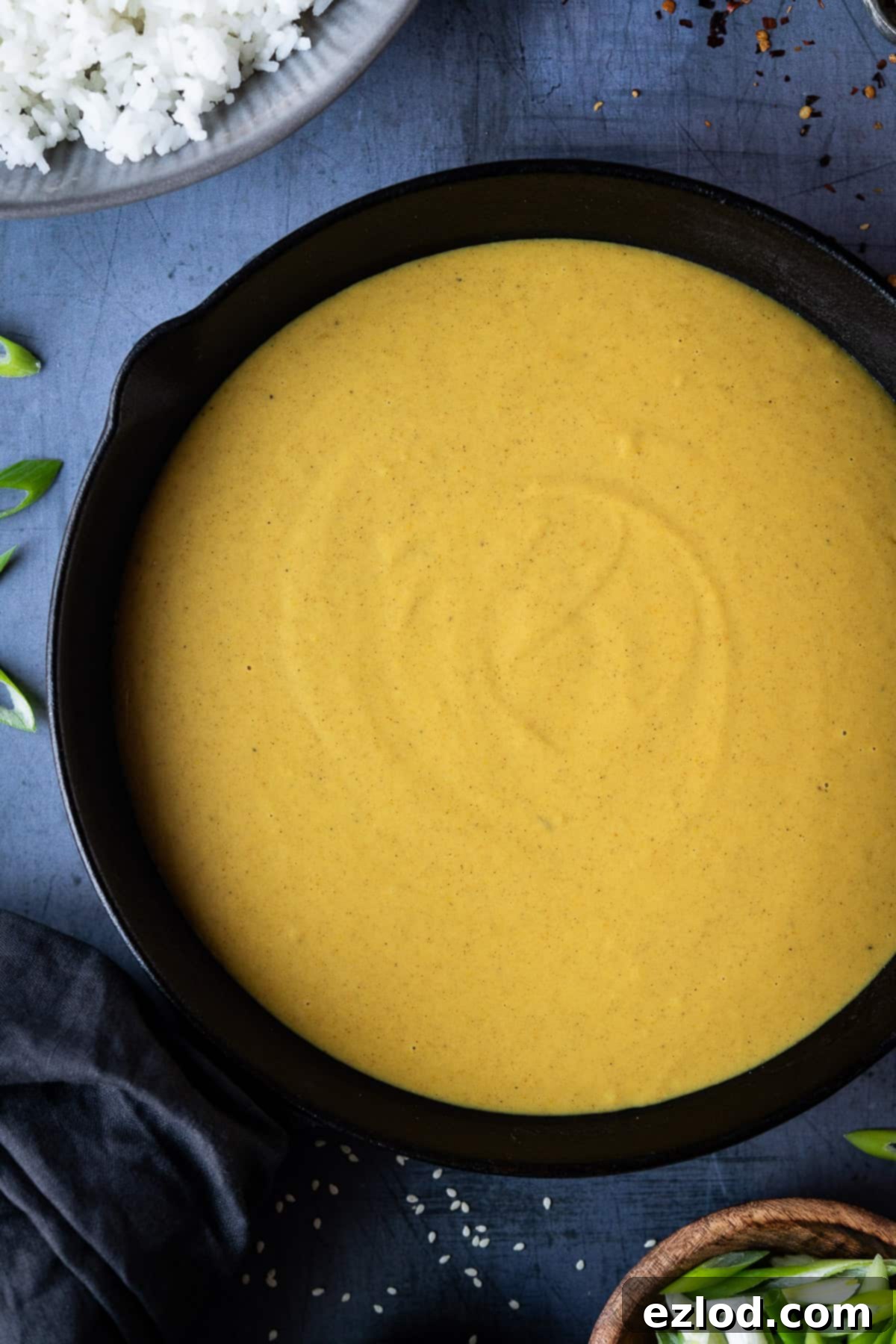
Planning Ahead: Make-Ahead & Storage Tips
This vegan Chinese curry sauce is not only delicious but also fantastic for meal prepping! You can easily make it in advance, making weeknight dinners a breeze.
- Refrigeration: The sauce will keep beautifully in an airtight container in the fridge for up to three days. Its flavors may even deepen slightly overnight, making it taste even better the next day!
- Freezing: For longer storage, this curry sauce freezes exceptionally well. Pour it into a freezer-safe, airtight container or heavy-duty freezer bags and store for up to three months. When ready to use, allow it to defrost completely in the refrigerator overnight, then reheat gently in a saucepan over medium heat or in the microwave, stirring occasionally until heated through. If it seems a little thick after reheating, you can add a splash of vegetable stock or water to reach your desired consistency.
Expert Tips for the Best Vegan Chinese Curry Sauce
To ensure your homemade vegan Chinese curry sauce is nothing short of perfect every time, keep these expert tips in mind:
- Don’t Skimp on Five-Spice: As mentioned, Chinese five-spice is the soul of this curry. It’s what gives it that signature takeaway flavor. Ensure you use a fresh, good quality blend for the best results.
- Blend for Smoothness: While optional, blending the sauce until completely smooth is highly recommended. It creates that luxurious, uniform texture typical of takeaway curries. A regular blender works great, or you can use an immersion (stick) blender for convenience, blending directly in the pot.
- Customize Your Veggies: Embrace seasonal produce! Almost any vegetable suitable for stir-frying or simmering will work. Think beyond the usual and experiment with different combinations to keep your meals exciting.
- Adjust to Your Palate: Taste as you go! The beauty of homemade cooking is tailoring flavors to your preference. Add more curry powder for intensity, extra five-spice for more aroma, a pinch more sugar for sweetness, or a dash of your favorite chili sauce (like Sriracha or sweet chili sauce) if you prefer a spicier kick. Remember to adjust salt and pepper at the end.
- Prevent Lumps with Cornflour: When adding the cornflour slurry, ensure it’s mixed well with cold water first. Then, stir it into the sauce gradually while the sauce is simmering, and continue stirring constantly for a couple of minutes until it thickens. This active stirring is crucial to prevent the cornflour from clumping and ensures a silky, lump-free sauce.
- Gluten-Free Option: If you need to make this recipe gluten-free, be aware that traditional soy sauce often contains wheat. Simply substitute regular soy sauce with tamari, which is a gluten-free alternative that offers a similar depth of flavor.
- Batch Cooking: This recipe is perfect for doubling or tripling if you want to make a larger batch for meal prep or to freeze for future quick dinners.
Explore More Delicious Vegan Curry Recipes:
If you’ve enjoyed this vegan Chinese curry, you’ll love exploring other plant-based curry creations. Here are some more of my favorites:
- Vegan Mushroom and Tofu Korma
- Easy Lemongrass and Coconut Curry
- Vegan Palak Paneer
- Chana Masala
- Red Lentil Dahl with Roasted Cauliflower and Butternut Squash
- Chickpea, Sweet Potato, and Spinach Curry
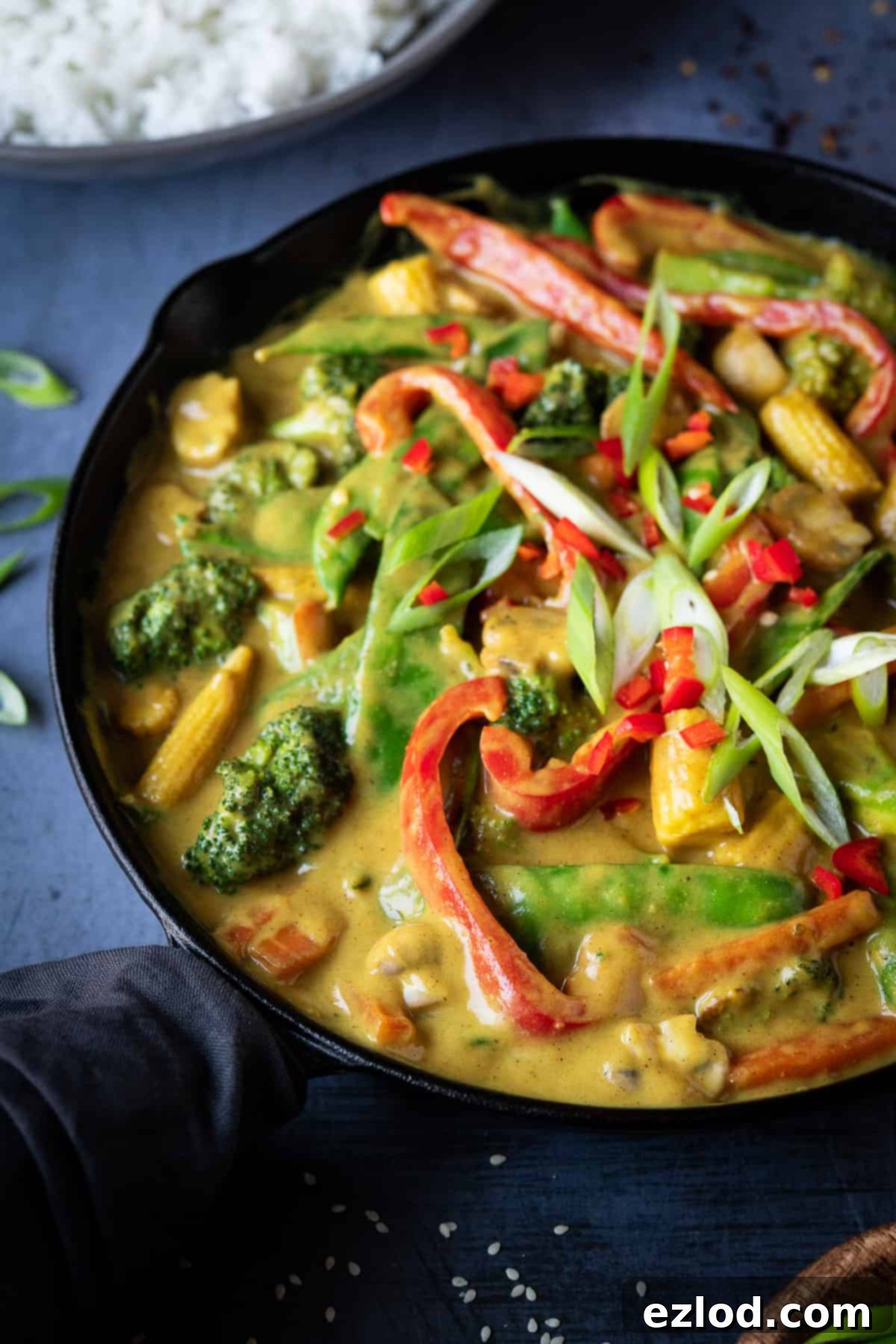
If you’ve had the pleasure of trying this incredibly satisfying vegan Chinese curry recipe, I would absolutely love to hear about your experience! Please take a moment to rate it, leave a comment below with your thoughts, or share your culinary creation on Instagram by tagging @domestic_gothess and using the hashtag #domesticgothess. Your feedback and beautiful food photos truly make my day!
*Please note that all images and content featured on Domestic Gothess are copyright protected. If you wish to share this recipe with others, kindly do so by utilizing the provided share buttons. We respectfully request that you refrain from screenshotting or reposting the recipe or its content in full. Thank you for your understanding and support!*

Print
Vegan Chinese Curry Sauce
Ingredients
- 2 Tbsp vegan butter (or olive oil)
- 1 brown onion finely chopped
- 1 Tbsp grated ginger (either fresh or from a jar)
- 4 cloves garlic peeled and crushed
- 4 tsp mild curry powder
- 1 ½ tsp Chinese five spice
- ½ tsp turmeric
- 400 ml (14 oz) tin of coconut milk (full fat is best but light will work too)
- 250 ml (1 cup) water
- 1 Tbsp dark soy sauce
- 1 tsp sugar
- 1 vegetable stock cube
- 1 ½ Tbsp cornflour (cornstarch)
Instructions
-
Heat the butter in a large pan over a low heat. Add the chopped onion and cook gently for about 10 minutes until the onion is soft.
-
Add the ginger, garlic, curry powder, Chinese five spice and turmeric. Cook for a couple of minutes, stirring often.
-
Add the coconut milk, water, soy sauce and sugar and crumble in the stock cube. Bring up to a gentle simmer and cook for 10 minutes.
-
Transfer the sauce to a blender and blitz until it is smooth then return it to the pan.
-
Place the cornflour in a small bowl and stir in 2 Tbsp cold water to form a slurry. Stir the slurry into the sauce then bring it up to a simmer. Cook for a couple of minutes, stirring constantly, until the sauce has thickened.
-
Season the sauce to taste with salt and pepper then serve with your choice of stir fried vegetables and/or cooked vegan chicken pieces or baked tofu.
Notes
- Serve the sauce with your choice of stir fried vegetables/cooked protein. See post above for ideas on what to use.
- I like to blend my sauce so that it is completely smooth. You can skip this step if you want however.
- The Chinese five spice is what gives the sauce it’s authentic takeaway flavour, do not omit it.
